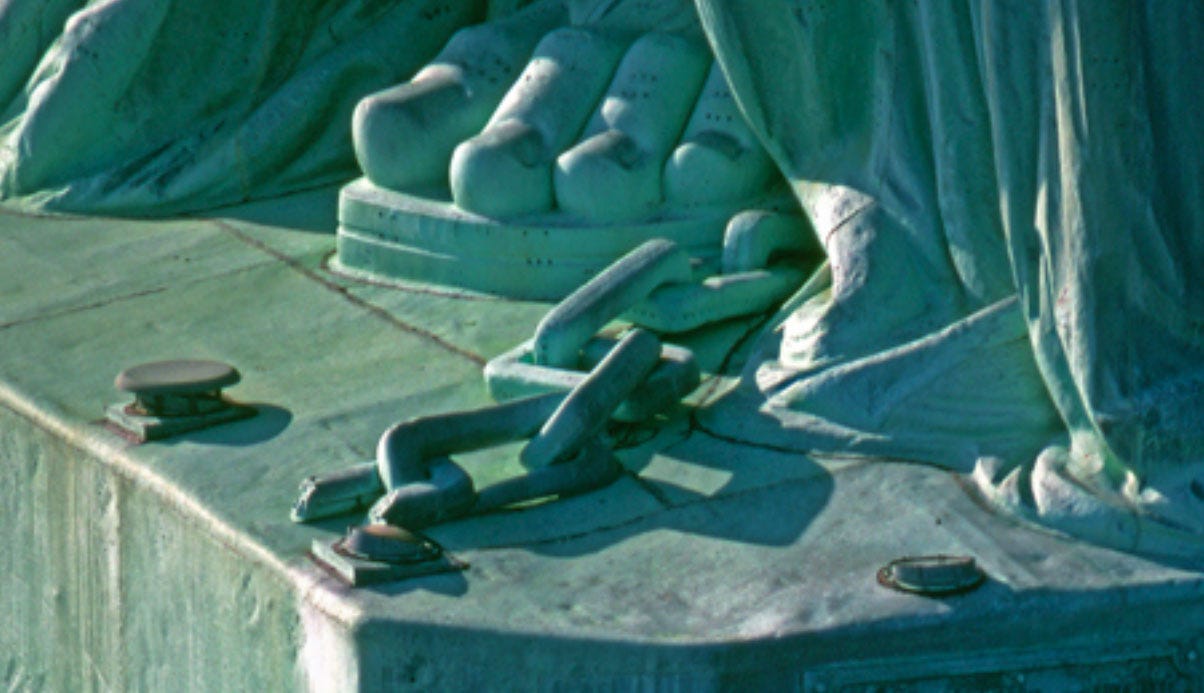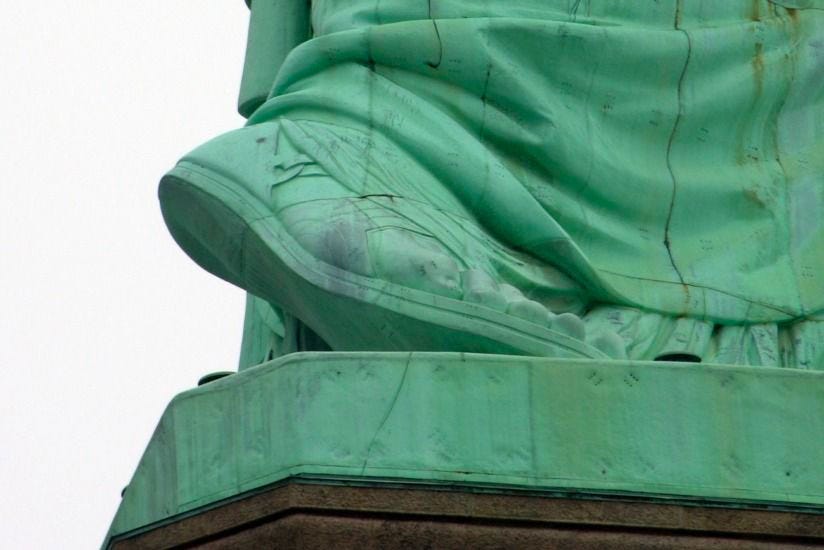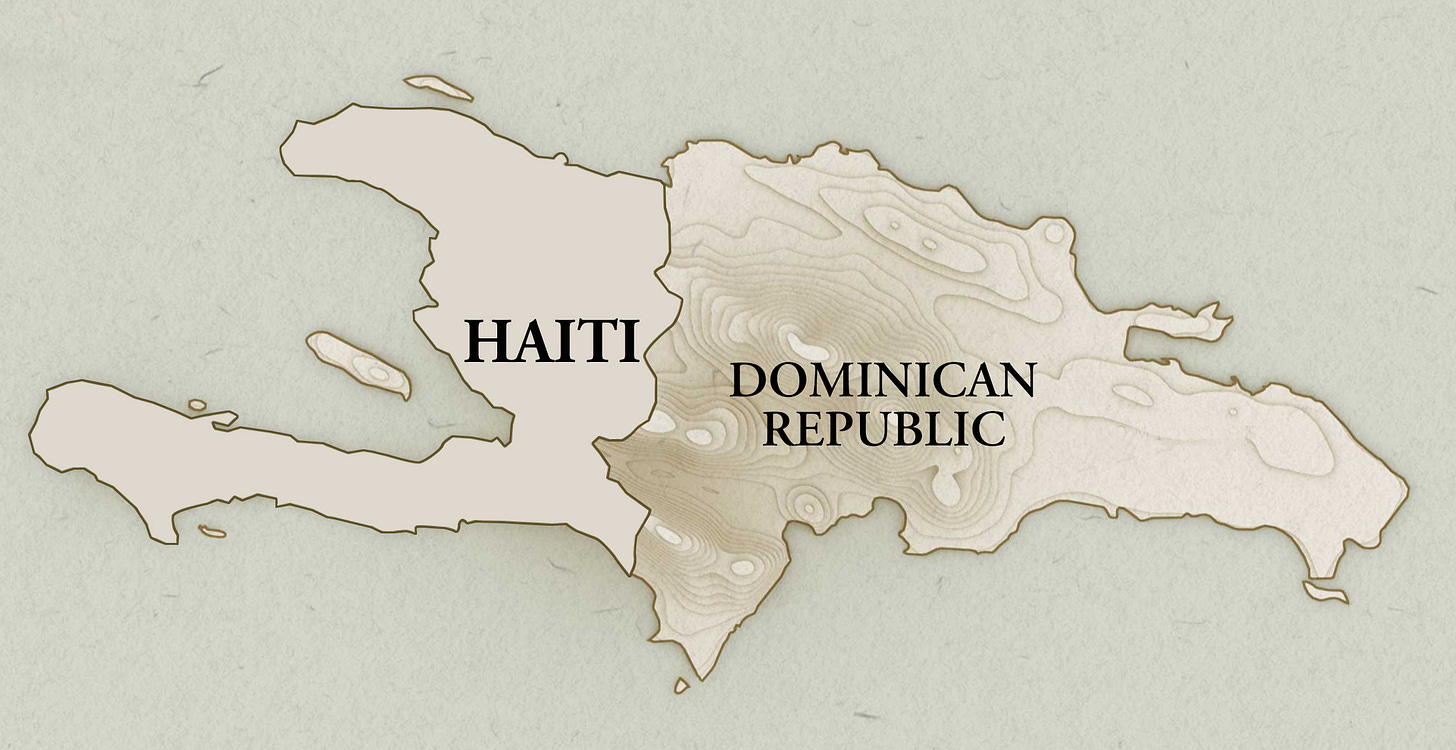Marching Upon the Ruins of the World
How the Haitian Revolution transformed the entire white world into Becky
Previously… A Diet of Robbery, Murder, and Violence – a very short account of the Spanish destruction of the West Indies
Chaulette
One of the central characters I’m developing for The Masters is a man named Chaulette – based on a real person of the same name, who surreptitiously entered Puerto Rico and other Spanish colonies, often under the cover of night by boat, then snuck inland for days at a time, mixing with the local slave population to agitate for uprisings.
Why Chaulette scared the f**k out of the Encomenderos of Puerto Rico
In 1804, white slave owners were killed by the thousand in Haitian streets and town squares under the orders of Jean-Jacques Dessalines. French women were forced to marry black men or die. Children were beheaded, and their heads placed on spikes. In Puerto Rico, the Spaniards were keenly aware that like the French, they were vastly outnumbered by slaves. And also, there was no reason to believe the revolution would stop with Haiti. University of Chicago historian Guillermo Baralt offers these observations:
The most direct form of Haitian revolutionary influence in Puerto Rico over the following years was the use of emissaries and agents who were sent there to foment anarchy and disorder. We have documents referring to a Haitian agent named Chaulette who arrived in Puerto Rico in November 1805. When this news was received, circulars were sent out to all the tenientes a guerra of the island’s districts. The circular announced his arrival, describing him as a mulatto of 18 to 20, a polyglot speaking English, French and Spanish, of medium height and with curly hair. Months later, it was discovered that Chaulette’s mission extended beyond the boundaries of the coasts of Puerto Rico. He was part of a general conspiracy of slaves in all the Caribbean colonies, coordinated from Haiti.
– Dr. Guillermo A. Baralt (Slave Revolts in Puerto Rico)
Note: the above analysis is based on original Spanish colonial documentation in AGPR Fondo documental manati legajo 1812, Circular No 37.
My Chaulette
He’s equal parts charismatic leader, strategist, insurgent, charmer, and intellectual. A protean self-made man who carries himself with the sure-footedness of an acrobat, and radiates a preternatural ease and stylish comportment in everything he does – whether that be wearing a suit, ordering a cup of coffee, stealing a 4th century Falcata blade from a museum, or tearing a man’s arm off and using it as a bridge stick during a game of pool. He’s a man who bristles with physicality and power. Quietly. He’s the man I have in mind to get the action going in the The Masters.
In my working draft, I put him in the world we know: New York City, 2020 during the height of Covid. He’s dying in a hospital bed in Brooklyn, barely able to breath, afraid and alone. Outside are two refrigerated trucks filling up with the bodies of the recently dead. Chaulette wonders how soon it will be before he joins them. And after, will he be tossed into Potter’s field? Or will Spillers’ people find him first, somehow figure out how to keep him alive, and vivisect him? He drifts in and out of consciousness, and occasionally dreams of Isidor.
How Haiti connects with the Masters
Magic
Haiti is fascinating to me because of the ease with which its people move between the world of the concrete and the world of the supernatural. One of my good friends – I’ll call him R – grew up in Haiti, then moved to New York City when he was in the 8th grade. He was a real math and science nerd who breezed through his classes in high school, picked up a physics degree in college, and now works as a software engineer. When I first met R, I thought it was odd how we could be talking about any old topic – quantum mechanics, comic books, real estate prices, the idiotic nature of the Perl programming language – then something would happen and he’d make a beeline to a story about spirits, loups-garous, and voudou. I eventually accepted this as an immutable fact of R’s personality.
Symbolism
The Haitian Revolution is the only time in the history of the world that enslaved people defeated their masters, expelled them from their lands, and formed a government. It’s astonishing to me that we don’t pay enormous attention to this when we learn about history. It’s as if there’s an ongoing concerted international effort to not just downplay its significance, but to actively diminish it; what de las Casas called an “effective conspiracy of silence”.
Have you ever looked at the feet of the Statue of Liberty?
If you examine her foot, you’ll see a chain. That chain is broken. When you look at her other foot, you’ll see her heel is off the pedestal – stepping forward with purpose. She’s on the move.
Lady Liberty was originally designed to celebrate the end of slavery, not the arrival of immigrants. Ellis Island, the inspection station through which millions of immigrants passed, didn’t open until six years after the statue was unveiled in 1886. The plaque with the famous Emma Lazarus poem — “Give me your tired, your poor, Your huddled masses yearning to breathe free” — wasn’t added until 1903.
– Washington Post (Lady Liberty was inspired by the end of the Civil War and emancipation. The connection to immigration came later)
Here’s her other foot.
Symbols are important. I love the statue of liberty, and see it almost every day. But as a New Yorker, an immigrant, and a person descended from slaves, I cannot help but magnify the importance of the chain.
What follows is a recap of historical information I’ve been looking at around the topic of the Haitian Revolution as it relates to The Masters.
Haiti 1791
It was given the name Saint-Domingue by the French and it was the most lucrative colony in the history of the world. By the 1780s, it was exporting 50% of the world’s coffee and 50% of its sugar – all off the labor of African slaves.
Approximately 800,000 slaves had been brought to Saint-Domingue during the French colonial period, yet fewer than 500,000 were living on the island by August 1791. Hundreds of thousands were murdered, or simply worked to death.
“The wealth [these slaves] produced went to the approximately 30,000 whites on the island.” (Jeremy D. Popkin, Facing Racial Revolution)
Who Lived in Saint-Domingue in the 1700s?
Les grands blancs
White conservative plantation owners who were unfriendly to the ideals of the French Revolution. They were absentee landlords for the most part, living high on the hog back in Paris. By 1791, this group was ready to split off from France, and accept protectorate status from Britain. They identified themselves by wearing a white cockade (les Pompons Blancs).
Les petits blancs
The lower classes of whites who generally embraced the ideals of the French Revolution, and thought of themselves as patriots. They weren't all French – many were professional criminals, adventurers, or international fugitives. They identified themselves by wearing a red cockade (les Pompons Rouges).
Mulattoes
Mixed-race people – sometimes referred to as gens de couleur – often fathered by a plantation owner. Some were enslaved, but most were free. Many mulattoes were financially successful, and some even owned slaves. There were 64 different shades of color identified and named among the mulattoes, each denoting its own social status depending on the lightness of the shade. There was a special animosity between the mulattoes, who had wealth but no political rights, and the petit blancs, who had rights but little money.
Affranchis
Freed people (former slaves).
Africans
The slaves.
Why is the Haitian Revolution Important?
1. Money & Power
The revolution created an enormous economic vacuum. Haiti supplied 50% of the world’s coffee and 50% of the world’s sugar. And with former slaves newly in charge, France gave zero shits about seeing that industry coming back. Naturally, some other place (hint: Puerto Rico) would have to (and did) make up for all that missing sugar and coffee. The New York Times recently published a detailed story about how Haiti’s crippling debt was engineered – first by military extortion, then financial extortion – all shortly after the revolution.
The Haitian Revolution had the profound impact that it did because it occurred in what was probably the most valuable of all overseas European colonies in 1789, a site central to the entire Atlantic economy.
– Jeremy D. Popkin, Facing Racial Revolution
2. It was the Stunner of Stunners
The thought of blacks, many of whom didn’t even have shirts or shoes, overrunning whites – literally forcing the army of Napoleon Bonaparte to surrender on the battlefield – was unthinkable (to whites).
What was at issue in the stories emanating from Saint-Domingue (Haiti) was the specter of people of color overthrowing the rule of white Europe on a vital part of its own terrain.
– Jeremy D. Popkin, Facing Racial Revolution
3. It Canonized the White Survival Procedural
The first common element is the background of sheer horror: the sudden inversion of power relations that turned whiteness from the sign of privilege to a pretext for extermination and the realization that white lives could be held as cheap as those of black slaves had been before the insurrection. The second common element… is the experience of total helplessness.
– Jeremy D. Popkin, Facing Racial Revolution
4. It legitimized the Presumption of Savagery
After the Haitian revolution, the international community characterized the outcome not as a victory of the oppressed, but as a savaging of civilization.
Revolutionary Saint-Domingue was one of the birthplaces of modern, pseudoscientific racism: in 1790, the baron de Beauvois, a member of the Royal Academy of Sciences and Arts in Cap Français became one of the first authors to assert unequivocally that blacks were an inherently inferior species of humanity, “different from the white race, physically and morally,” their “faculties…, so to speak, nonexistent.”
– Jeremy D. Popkin, Facing Racial Revolution
5. It shows us 2 different kinds of Freedom
Freedom TO – inflict pain, misery, financial ruin, and death. Enjoyed by slaveholders
Freedom FROM – all of the capricious whims of the slaveholder
And the two freedoms definitely come into conflict. Consider the timeline:
1776 – American revolution begins with the signing of the declaration of independence
1789 – George Washington assumes the presidency
1789 – French revolutionaries storm the Bastille, many people are killed (by white freedom lovers). The revolutionaries form the national assembly as a governing body
1789 – Haitian mulattoes send delegates to Paris basically saying… can we get in on some of this Liberté, égalité, fraternité please? Maybe we just start with the right to vote…? The French basically say… oh shit. We didn’t mean you guys.
1791 – Thomas Paine publishes The Rights of Man, arguing that people have the inherent right to overthrow governments
1791 – Haitian Revolution kicks off with scattered skirmishes, led by Dutty Boukman.
1802 – Napoleon’s army invades Haiti. They capture or turn key leaders of the revolution. Things go well for the French, then go badly. 10,000 French soldiers die of yellow fever. Polish forces, sent by Napoleon to augment the French, figure out that they’re being asked to kill slaves who are fighting for their own freedom. Then they say fuck this shit. We’re fighting with the slaves! As a result, Poles earn the moniker of European white negroes and are later constitutionally recognized as black.
1803 – Rochambeau cuts his losses, and retreats, taking several hundred white civilians with him on a British ship.
1804 – Dessalines declares victory. Shortly after, he orders the mass executions of surviving whites, branding them as traitors. People don’t comply. Dessalines shows up to various locations, whips people up with speeches about French atrocities, then supervises brand new atrocities against white people in town squares and city streets. The details of these killings are the only thing that white people are encouraged to remember about the entire Haitian revolution.
What does the White Response to the Haitian Revolution help explain?
Why Dr. Marion Sims thought it perfectly reasonable to vivisect 14 year old black girls without anesthesia
Black women don’t feel pain. [Lucy’s bladder was destroyed], leaving an opening between the vagina and the bladder, at least two inches in diameter or more… That was before the days of anaesthetics… I had about a dozen doctors there to witness the series of experiments that I expected to perform. All the doctors had seen my notes often and examined them, and agreed that I was on the eve of a great discovery, and every one of them was interested in seeing me operate.”
– Washington Post (A surgeon experimented on slave women without anesthesia. Now his statues are under attack)
Why Cops routinely overestimate the body weight of people from photos, once they determine the person they’re looking at is black
Dr. Jennifer Eberhardt is a neuroscientist who studies bias, and works with law enforcement to figure out ways to reduce the incidents of avoidable police-inflicted deaths that result from snap judgements.
Humans have evolved to detect threat. And assessments of the physical stature and strength of others help us to determine what kind of threat they pose to us and what kind of force would be required to subdue them. Although there are reams of studies demonstrating that blacks are perceived as threatening, we have relatively little understanding of how race could warp people’s perceptions of physical stature. Three researchers, John Paul Wilson, Kurt Hugenberg, and Nicholas Rule, sought to correct this.
In a series of studies, they asked people to rate the height, weight, and strength of young black and white men from photographs showing only their faces. Study participants consistently rated black men as taller, heavier, and stronger than white men.
– Dr. Jennifer Eberbardt (Biased)
Why GOP senators think that President Obama wearing a tan suit at a press conference is an emergency
There's no way, I don't think, any of us can excuse what the president did yesterday.
– Peter King (Obama Tan Suit Controversy)
Why white people travel across state lines with assault rifles to “help out”, then kill people and act completely surprised
Kyle Rittenhouse drove his car from Illinois to Wisconsin with an assault rifle, killed two people, then explained that he did this because he feared for his life.
They called themselves citizens or patriots,… but it would have been most accurate to call them paramilitaries: young-to-middle-aged white men, mostly, armed with assault-style rifles and often clad in tactical gear, who appeared in town that evening arrayed purposefully around gas stations and used-car lots. Law-enforcement officers seemed to have broadly tolerated, and occasionally openly expressed support for, their activities, despite the fact that many of them were violating the same emergency curfew order under which dozens of demonstrators were arrested.
Kyle Rittenhouse, 17, who lived just across the state line in Illinois, arrived in Kenosha the night before. The next day, he joined several other young men in the defense of the dealership where Harris encountered him. Less than two hours later, he would shoot three men, killing two and wounding the third, and transforming himself, in an instant, into a Rorschach test.
– New York Times (Kyle Rittenhouse and the New Era of Political Violence)
How the weaponization of white hysteria works: a repeatable playbook
When correctly phrased, white speakers can emit verbal instructions that act like the electronic distress signal used by Captain Carl Majors to summon Godzilla in times of need.
“an African-American man is threatening my life”
– Amy Cooper (white woman)
👇🏽 The African-American man/birdwatcher on the receiving end of Amy Cooper’s hysteria had this to say.
“What she did was tap into a deep vein of racial bias,” Mr. Cooper added. “And it is that deep vein of racial bias that keeps cropping up that led to much more serious events and much more serious repercussions than my little dust-up with Amy Cooper — the murder of George Floyd, the murder of Ahmaud Arbery, and before that Amadou Diallo and Patrick Dorismond and Eric Garner and Tamir Rice.”
– New York Times (How 2 Lives Collided in Central Park, Rattling the Nation)









